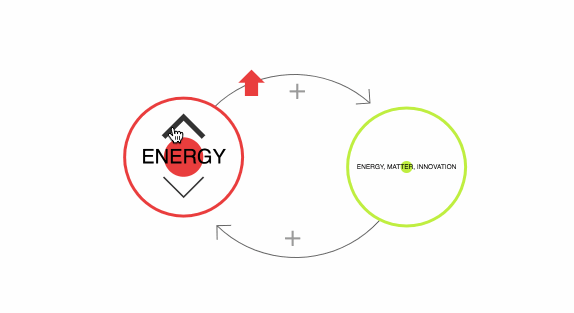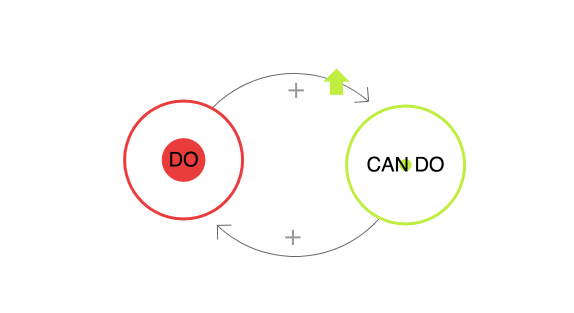The More You Do, The More You Can Do
On Jim Rutt's recent podcast with Matt Ridley, Matt gave a phrasing of feedback loops that I'd never heard before, but is quite powerful. Here's the phase:
The more you do, the more you can do.
Here's how came up in conversation. Matt was describing how crucial the steam engine was to the Industrial Revolution. The steam engine takes heat (from coal) and turns it into work (turning gears to automate labor processes). We call this heat-to-work. Before this, we only had heat (fire) on one side and work (human and animal labor) on the other. We hadn't connected heat to work. The steam engine made this connection.
The more you do heat-to-work, the more work you can do. This "increase in what you can do" comes from more energy, more matter, and more time for innovation. Steam engines gave us more people and time to invent a better steam condenser, more access to matter like iron to create lots of condensers, and more energy to create and transport them around the world on steamboats and railroads. Steam engines provide energy to create more steam engines.
We can visualize this as energy providing more energy, matter, and innovation, which leads to more energy.

The inputs to the heat-to-work process are also the outputs of it. Progress in heat-to-work technology requires energy, access to resources, and innovation, which are the outputs of heat-to-work technology.
The more you do heat-to-work, the more you can do heat-to-work.

(I've added an Orbit study break below. It helps you remember things, not just read them.)
In fact, this pattern shows up at many other times in history.
- Around 2.5M years ago, sapiens began to use stone tools, which allowed them to access energy (in bone marrow and breaking nuts), which increased the size of their brains, which allowed them to make better tools. Tools -> energy -> brains -> tools. Tool innovation begets more tool innovation. The more you do, the more you can do.
- Around 10,000 BCE, we began to farm. Farming fed more people, who could do more farming. Farming -> energy -> people -> farming. Farming begets farming. The more you do, the more you can do.
- There are other ways to frame the Industrial Revolution besides heat-to-work. You could say that science led to innovations like fossil fuels, the Haber process and the printing press, which led to more people who are more networked, which led to more science. Science -> networked minds -> science. Science begets science. The more you do the more you can do.
All of these loops share a key characteristic: they produce energy rather than consume it. The left side of each loop is always "energy" and the right side is "stuff to make more energy." It's difficult to keep a feedback loop going if you don't have the energy to self-sustain it.
Jason Crawford calls all of these supply-side loops. He gives some other examples below:
What are some good examples of reinforcing cycles in technology?
— Jason Crawford (@jasoncrawford) December 11, 2020
For instance:
• Steam, coal, iron, and railroads. Each supported the other three
• Plastic helps to drill oil; oil is the feedstock for plastic
• Computers optimize the supply chain, which helps make computers
We could reframe each to our "do <> can do" energetic frame:
- Steam/coal (energy) -> iron/railroads -> steam/coal.
- Oil (energy/matter) -> plastic -> oil.
- Optimized supply chain (efficient use of energy) -> computers -> better supply chain.
In each, we're creating more supply through energy production.
Notes
In a future post we'll cover other kinds of technological feedback loops like:
The replies, plus some brainstorming, make me realize that there are multiple *kinds* of feedback loops. My examples were supply-side loops. But there's also:
— Jason Crawford (@jasoncrawford) December 11, 2020
• Demand-side (network effects)
• Economies of scale
• More abstract loops like science <> technology
What else?
And:
- Computers make circuit design easier makes more computers.
- Better software development tools help build even better software development tools.
- Cars create an incentive for the building and improvement of roads which encourages/enables more cars.
- How DNA sequencing gives us more discoveries to do more DNA sequencing.
Question: a [do <> can do] feedback loop underlies energetic transitions like the Agricultural Revolution and Industrial Revolution. What about computers and the Information Age?
Maybe we can even claim this loop for biological evolution?
- The more cyanobacteria did photosynthesis, the energy they got to reproduce and spread in the world, and the more DNA mutations could happen to get better photosynthesis. Photosynthesis -> # of organisms -> better photosynthesis.
- Or for the Cambrian explosion. Energy through respiration -> more organisms -> positive DNA mutations -> more energy. (The rate of evolution increased 10x during this period.)